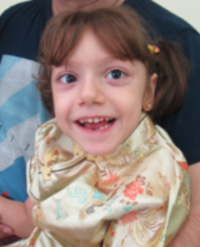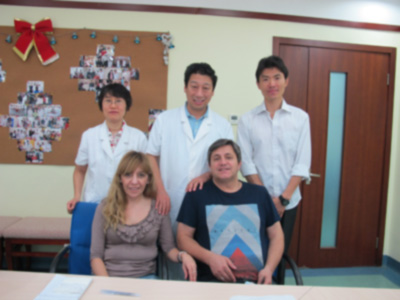Maria - Cerebral palsy (Argentina) Posted on September 18, 2013
Name: Maria Paz Lastra 
Sex: Female
Country: Argentina
Age: 6 years
Diagnoses: Cerebral palsy, Epilepsy, Mild anemia
Admission Date: 2013-08-15
Days Admitted to the Hospital: 32
Before treatment:
She was born during the 30th week of her mother's pregnancy. The weight at birth was 1.2kg. The patient had 3 operations for intestinal obstruction when she was 20 days old. After the operations, the patient suffered from a developmental delay of motor function, speech and visual development. She was diagnosed with cerebral palsy, high myopia of both eyes and astigmatism. She received rehabilitation and visual training every day. The effect was not good. She suffered from epileptic seizure 4 months ago. She had Chickenpox 1 month ago. At present, the patient was unable to turn over, crawl, sit up or walk. Her main diet was milk. The sleep was almost normal. She had urinary incontinence and stool irregularity.
PE:Height: 96cms, weight: 12kgs. Her development was slow. Her nutrition was somewhat poor. The abdomen was even, with many scars from previous operations. There was tympanitic note when tapping the abdomen. There were no masses in her abdomen. The liver and spleen were not palpable under the ribs. The patient was alert. She had a speech disorder and could only sound out the words "grandma" and "Papa". She could not perform the memory, calculation or orientation examinations. Her ability to comprehend was decent. She could communicate with her parents at a fundamental level. Both pupils were equal in size and round. The diameter of the pupils was 3.5mms. Both eyes were flexible to light stimuli. Both eyes had high myopia and astigmatism. The forehead wrinkle pattern was symmetrical. The nasolabial sulcus was equal in depth. She could move her neck to the left and right in supine position. She had trouble supporting her head while in a seated position. Her head would sometimes droop or fade-away. The muscle strength of her waist and back was poor. She could not turn over or maintain a seated position. She was not able to grasp objects with either of her hands. Both lower limbs would move involuntarily. She could not raise her leg off the surface of the bed. The patient's left lower limb is 2 cm shorter than the right lower limb because her left hip joint is dislocated. She could not perform the muscle strength examination of her four limbs. The muscle tone of her four limbs was higher. Adducted to both thumbs and she could not grasp objects. Her abdominal reflexes were weak. The tendon reflex of both upper limbs was normal. The tendon reflex of both lower limbs was active. Bilateral Achilles tendon reflex was not elicited. Bilateral ankle contracture was positive. Bilateral sucking reflex was negative. Bilateral palm jaw reflex was negative. The bilateral Hoffmann sign was negative. Bilateral pathological reflex was positive. She could not perform the sensory examination or the movement coordination examination.
Treatment:
After admission, the patient performed the relevant examinations. She received nerve regeneration treatment and stem cell activating treatment. She was given treatment to improve the blood circulation in order to increase the blood supply to the damaged nerves and nourishment for the neurons. She also received treatment to boost her immunity. This was combined with daily physical rehabilitation therapy.
Post-treatment:
The patient's height: 97.5cm, weight: 12.5Kg. She has a better diet. The patient's language, vision and muscle strength of the limbs is better than before. The patient is better able to independently pronounce words and her language retelling ability has improved. Her ability to pay attention and comprehend has improved. She is better able to move her eyes with ease; her vision is better than before. The visual field is enlarged. She is better able to support her neck, chest and waist. The muscle strength of her four limbs is better than before. At present, the patient can turn over by herself. She can independently maintain a seated position for several minutes. The muscle tone of her four limbs has been reduced, in comparison to before. Both thumbs can abduct and grasp small objects. After treatment, the dislocation of the left hip joint has been alleviated and the length of both lower limbs is equal. The range of hip joint motion is increased.

(Download the Windows Media Player Firefox Plugin if you are using Firefox browser.
To know more,Please read Using the Windows Media Player plugin with Firefox.)
Date: 2013-12-17
Dr. Wu
Hi, I'm writing this e-mail to send you the last analysis that we made to Maria Paz. I wanted to ask you if we can give her any medicine because she doesn't want to eat. Can we do something? She never is hungry.
Whatever, she es getting better every day. She has evolved a lot. The problems in her eyes has improved. The ophthalmologist evaluated her and relized that sightedness and stigmatism have decreased. What is more the therapist (who is with my daughter three days a week) said that Maria Pazstares and track objects for longer than before. Cognitively, now she chooses what she wants to play to. (usually with dolls -feed, drees or bath them). She can distinguish between an animal, or a fruit. She recognizes the colours and pays more atention while she plays games with sense.
About her body she is improving her position, now she can mantain her head during more time tan before and, for moments, she stays sitting alone. We can see that she wants to walk, and her hands are totally open.
Thank you because of your dedication and experience. Our daughter is notably getting better!
Next e-mail I will send you the informs from therapists and doctors.
Mostrar historial de mensajes
The second round treatment:
Name: Maria Paz Lastra
Sex: Female
Country: Argentina
Age:7 years
Diagnoses: Cerebral palsy, Epilepsy
Date: September 08, 2014
Days Admitted to Hospital: 26 days
Before treatment:
The patient received treatment in August 2013 in our hospital. After treatment, she was able to move her eyes with ease; her vision was better than before. The visual field was enlarged. She was able to support her neck. The saliva was alleviated obviously. She had better learning ability. She had more speech. The patient's four limbs had more activities. But the patient still couldn’t turn over, crawl, sit or walk. She suffered from language barrier. For further therapy, the patient came to our hospital again.
Admission PE:
BP: 89/52mmHg, Hr: 112/min, Br: 24/min. Height: 104cms, weight: 13kgs. She suffered from developmental retardation and the appetite was poor. Her nutrition was poor and she was thin. Her skin and mucosa were normal, with no yellow stains. Her thorax was symmetrical. The respiratory sounds in both lungs were clear, with no signs of dry or moist rales. Her heart sound was strong, but the rhythm was irregular. There was no obvious murmur in the valves. The abdomen was flat, with many scars from previous operations. There was tympanitic note when tapping the abdomen. There were no masses in her abdomen. The liver and spleen were not enlarged.
Nervous System Examination:
The patient was alert. She had a speech disorder and only could say some words like "grandma" and "Papa". She could not perform memory, calculation or orientation examinations. Her ability to comprehend was decent. She had a simple communication with her parents. Both pupils were equal in size and round. The diameter of the pupils was 3.5mms. Both eyes were flexible to light stimuli. The patient's language, eyesight and muscle strength of the neck were better than last year. The saliva had reduced obviously. The learning ability had improved than last year. She had more language. The movement of four limbs had increased. The forehead wrinkle pattern was symmetrical. The nasolabial sulcus was equal in depth. She could move her neck to the left and right in supine position. She had trouble supporting her head while in a seated position. Her head would sometimes droop or lean back. The muscle strength of her waist and back was poor. She could not turn over or maintain a seated position. Both hands had slight grasp action. But her hands still couldn't hold object. Both lower limbs had active movement. She could not raise her leg off the surface of the bed. She could not perform the muscle strength examination of her four limbs. The muscle tone of both her upper limbs was normal. The muscle tone of both her lower limbs was slightly higher. Her abdominal reflexes were not elicited. The tendon reflex of both upper limbs was normal. The tendon reflex of both lower limbs was active. Bilateral Achilles tendon reflex was not elicited. There was ankle contracture in her ankles. Bilateral sucking reflex was negative. Bilateral palm jaw reflex was negative. Bilateral Hoffmann sign was negative. Bilateral pathological reflex was positive. She could not perform the sensory examination or the movement coordination examination.
Treatment:
After admission, the patient performed the relevant examinations. She received treatment for nerve regeneration and to activate stem cells in the body. She was given treatment to improve the blood circulation in order to increase the blood supply to the damaged nerves and nourishment for the neurons. She also received treatment to boost her immunity. This was combined with daily physical rehabilitation therapy.
Post-treatment:
The patient's condition has improved. Her body has further development. The patient's appetite is better than before. The muscle strength of her waist and back is stronger than before. She is able to turn over from supine position to side-lying position by herself.
